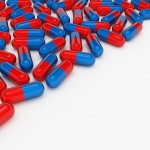
Clinical trials in the field of social anxiety to date have primarily focussed on the effect of either anxiolytic medication or cognitive behavioural therapy (CBT). At best these trials have demonstrated only moderate efficacy for either treatment independently (Davidson et al, 2004; Clark et al, 2003; Heimberg et al, 1998; Stein et al, 1998), and attempts to improve treatment response by combining the two specifically for social anxiety disorder have mostly shown disappointing results (Blomhoff et al, 2001; Otto et al, 2005).
There has been recent interest in D-cycloserine and its possible application in treatments for anxiety disorders; as it has been suggested that it may facilitate the process of extinction in learned fear. Hoffman and colleagues (Hoffman et al, 2013) aimed to test whether D-cycloserine can improve the speed and quality of response to a full course of CBT in adults with generalised social anxiety disorder.
Methods
This was a randomised, double-blind, placebo-controlled treatment trial involving 169 adults with social anxiety disorder. Participants were enrolled onto a 12 week programme of group CBT, and were given either 50mg of D-cycloserine or of a placebo one hour prior to five of the sessions. They were then followed-up over a six month period.
The primary outcomes for the study were:
Response: defined as “very much improved” or “much improved” on the Social Phobic Disorders Change Scale
Remission: defined as an improvement score on the Social Phobic Disorders Change Scale and a score of less than 30 on the Liebowitz Social Anxiety Scale
Results

Although D-cycloserine may not amplify the effects of CBT in the longer term it may temporarily accelerate early treatment gains
- There were improvements in response and remission rates within both groups and these were maintained at follow-up in both conditions. The difference between groups however was not statistically significant for either response or remission rate.
- Post treatment there was a trend towards lower scores on the Liebowitz Social Anxiety Scale for those given D-cycloserine compared to placebo (estimated parameter for treatment effect: 5.22; t=1.75, df=146, p=.08).
- Also at post treatment the D-cycloserine group had lower mean global illness severity scores than the placebo group (estimated parameter for treatment effect: 0.43; t=20.5, df=149, p=.04).
- During treatment the D-cycloserine group showed a significantly faster rate of improvement than those on placebo in relation to:
- Global illness severity (estimated parameter for treatment effect: 0.06; t=2.76, df=129, p=.006).
- Social anxiety symptom severity score (estimated parameter for treatment effect: 0.65; t=2.18, df=147, p=.03).
- Remission rate (estimated parameter for treatment effect: -0.10; t=2.59, df=1661, p=.01).
Conclusions
The overall conclusion of the study was that D-cycloserine did not improve treatment response when added to a full course of CBT for social anxiety disorder. This does not support the findings of the authors initial pilot study (Hoffman et al, 2006) and other previous research (Guastella et al, 2008).
The results however, in line with others (Siegmund et al, 2011; Hofmann et al, 2011), suggest that although D-cycloserine may not amplify the effects of CBT in the longer term it may temporarily accelerate early treatment gains and therefore suggest a possible role for D-cycloserine in reducing distress during exposure treatments.
It was suggested that variations in the dose or dose timings of D-cycloserine may yield different results, and that certain subgroups of people, such as those with a specific genotype or those who show greater within-session progress, may be more likely to benefit. This may therefore be worth exploring in the future.
Links
Hoffman SG, Smits JAJ, Rosenfield D, Simon N, Otto MW, Meuret AE, Marques L, Fang A, Tart C, Pollack MH. D-Cycloserine as an augmentation strategy with cognitive behavioural therapy for social anxiety disorder. Am J Psychiatry 2013; 170:751-758. [PubMed abstract]
Davidson JR, Foa EB, Huppert JD, Keefe FJ, Franklin ME, Compton JS, Zhao N, Connor KM, Lynch TR, Gadde KM. Fluoxetine, comprehensive cognitive behavioral therapy, and placebo in generalized social phobia. Arch Gen Psychiatry 2004; 61:1005–1013.
Clark DM, Ehlers A, McManus F, Hackmann A, Fennell M, Campbell H, Flower T, Davenport C, Louis B. Cognitive therapy versus fluoxetine in generalized social phobia: a randomized placebo-controlled trial. J Consult Clin Psychol 2003; 71: 1058–1067. [PubMed abstract] http://www.ncbi.nlm.nih.gov/pubmed/14622081
Heimberg RG, Liebowitz MR, Hope DA, Schneier FR, Holt CS, Welkowitz LA, Juster HR, Campeas R, Bruch MA, Cloitre M, Fallon B, Klein DF. Cognitive behavioral group therapy vs phenelzine therapy for social phobia: 12-week outcome. Arch Gen Psychiatry 1998; 55:1133–1141.
Stein MB, Liebowitz MR, Lydiard RB, Pitts CD, Bushnell W, Gergel I. Paroxetine treatment of generalized social phobia (social anxiety disorder): a randomized controlled trial. JAMA 1998; 280:708–713.
Blomhoff S, Haug TT, Hellström K, Holme I, Humble M, Madsbu HP, Wold JE. Randomised controlled general practice trial of sertraline, exposure therapy, and combined treatment in generalised social phobia. Br J Psychiatry 2001; 179:23–30.
Otto MW, Smits JAJ, Reese HE. Combined psychotherapy and pharmacotherapy for mood and anxiety disorders in adults: review and analysis. Clin Psychol 2005; 12:72–86.
Hofmann SG, Meuret AE, Smits JAJ, Simon NM, Pollack MH, Eisenmenger K, Shiekh M, Otto MW. Augmentation of exposure therapy with D-cycloserine for social anxiety disorder. Arch Gen Psychiatry 2006; 63:298–304.
Guastella AJ, Richardson R, Lovibond PF, Rapee RM, Gaston JE, Mitchell P, Dadds MR. A randomized controlled trial of Dcycloserine enhancement of exposure therapy for social anxiety disorder. Biol Psychiatry 2008; 63:544–549. [PubMed abstract] http://www.ncbi.nlm.nih.gov/pubmed/18179785
Siegmund A, Golfels F, Finck C, Halisch A, Räth D, Plag J, Ströhle A. D-Cycloserine does not improve but might slightly speed up the outcome of in-vivo exposure therapy in patients with severe agoraphobia and panic disorder in a randomized double blind clinical trial. J Psychiatr Res 2011; 45:1042–1047. [PubMed abstract] http://www.ncbi.nlm.nih.gov/pubmed/21377691
Hofmann SG, Smits JAJ, Asnaani A, Gutner CA, Otto MW. Cognitive enhancers for anxiety disorders. Pharmacol BiochemBehav 2011; 99:275–284. [PubMed abstract] http://www.ncbi.nlm.nih.gov/pubmed/21134394


D-cycloserine does not improve CBT for social anxiety disorder, but may accelerate early treatment gains: Clin… http://t.co/ePGp8wkJ7H
@kathryn_amy87 blogs about an RCT of D-cycloserine (added to CBT) for social anxiety disorder http://t.co/1Eyg8nWaEd
RCT finds that D-cycloserine doesn’t improve treatment response when added to full course of CBT for social anxiety http://t.co/1Eyg8nWaEd
Don’t miss: D-cycloserine does not improve CBT for social anxiety disorder, but may accelerate early treatment gains http://t.co/1Eyg8nWaEd
Mental Elf: D-cycloserine does not improve CBT for social anxiety disorder, but may accelerate early treatment gains http://t.co/s2GHye37gA
The issue is a bit more complicated. Answers to scientific questions often cannot be reduced to simple “yes” and “no’s.” This is the case with DCS.
The answer to the question (Does DCS augment exposure therapy of anxiety disorders?) is: it depends. As correctly noted, our recent trial published in the Am J Psychiatry showed that DCS does not lead to higher response rates, but it speeds up the treatment gains. This is consistent with other studies.
More importantly, we found in some post-hoc analyses that the effect of DCS greatly depends on the success of the exposure practices; DCS is a cognitive enhancer that not only augments extinction learning, but also fear memory reconsolidation. If fear is not sufficiently reduced during the exposure trial, DCS can augment fear memory reconsolidation. In other words, DCS makes good exposures better and it makes bad exposures worse. This is what we found in the re-analyses of our data (J Psychiatric Res) and also in another study (Biol Psychiatry).
Smits JA, Rosenfield D, Otto MW, Marques L, Davis ML, Meuret AE, Simon NM, Pollack MH, Hofmann SG. D-cycloserine enhancement of exposure therapy for social anxiety disorder depends on the success of exposure sessions. J Psychiatr Res. 2013 Oct;47(10):1455-61. doi: 10.1016/j.jpsychires.2013.06.020. Epub 2013 Jul 16.
Smits JA, Rosenfield D, Otto MW, Powers MB, Hofmann SG, Telch MJ, Pollack MH, Tart CD. D-cycloserine enhancement of fear extinction is specific to successful exposure sessions: evidence from the treatment of height phobia. Biol Psychiatry. 2013 Jun 1;73(11):1054-8. doi: 10.1016/j.biopsych.2012.12.009. Epub 2013 Jan 16.